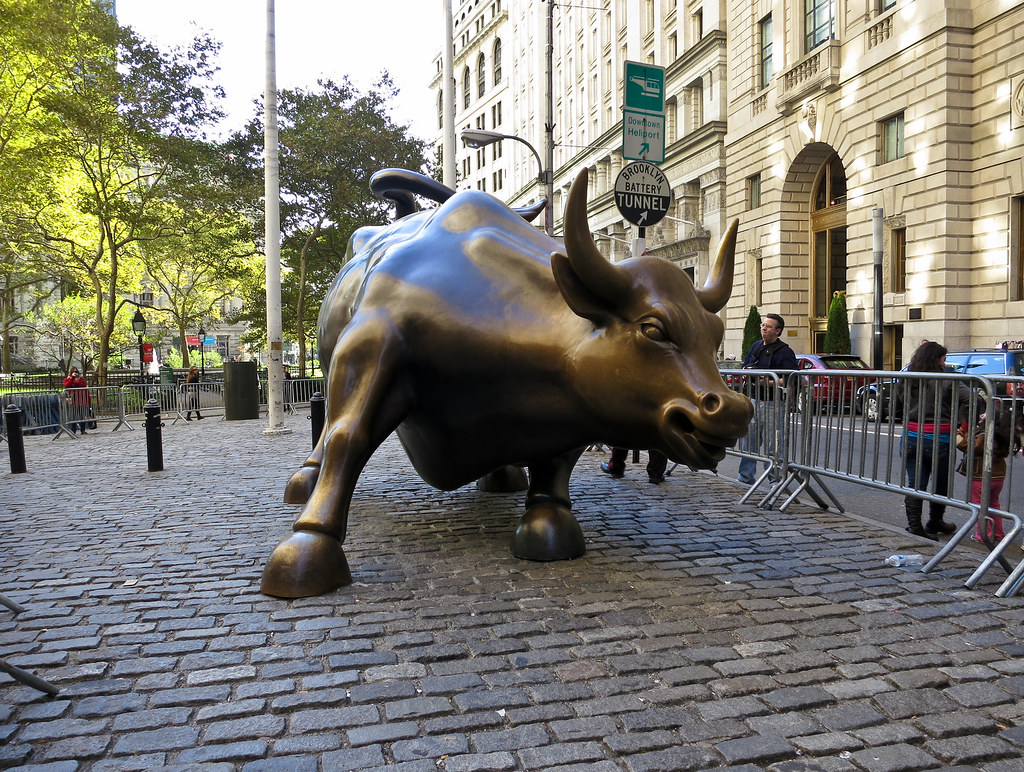In 2025, tariffs loom large.
As an investor, you may be wondering: How can I set my portfolio up for success in the Donald Trump economy?
Here’s the good news: The markets have seen volatility before, and they’ve always proven resilient. Additionally, there will always be stocks making gains — it’s all about knowing where and how to find them.
Knowledge is power — below, we’ll demystify the stock market under Donald Trump so you can invest more confidently.
Want to know how we find stocks before they explode?
With a Zen Investor subscription, you can save precious research time and let a 40+ year market veteran do the heavy lifting for you. Here’s what you get:
✅ Portfolio of up to 30 of the best stocks for the long haul, hand-selected by Steve Reitmeister, former editor-in-chief of Zacks.com with a 4-step process using WallStreetZen tools
✅ Monthly Commentary & Portfolio Updates
✅ Sell Alerts if the thesis changes
✅ Members Only Webinars
✅ 24/7 access to all the elements noted above
✅ Access to an archive of past trades and commentary.
Making Sense of the Donald Trump Stock Market
In terms of the financial markets, President Trump’s second administration has been the inverse of his first term in many ways.
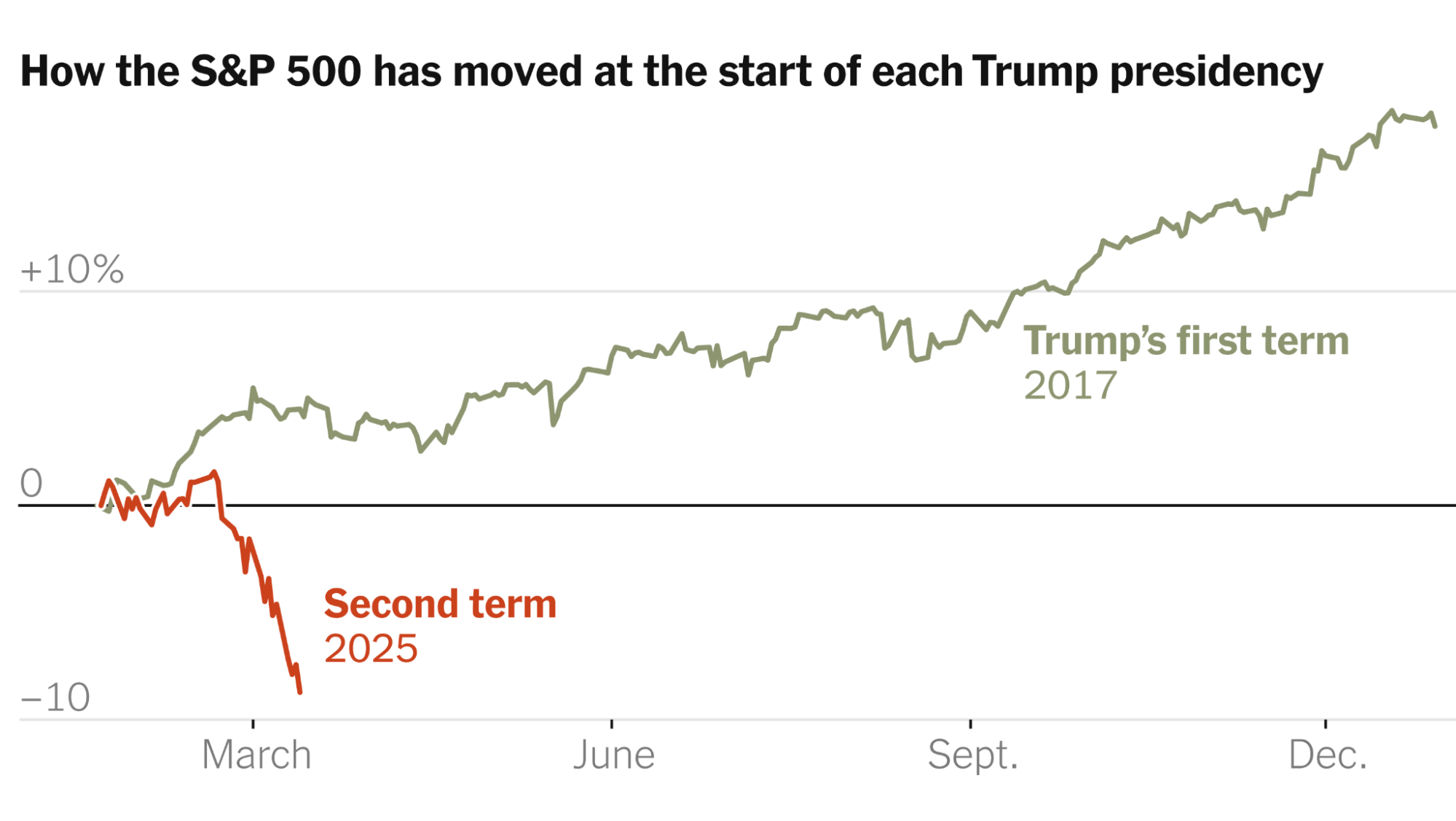
In 2017, he started his Presidency with accelerating economic growth and low inflation, meanwhile, interest rates were near the lower bound with the Fed funds rate at 0.5%. Thus, the stock market steadily rose with minimal volatility, for the most part during his first term.
There were two exceptions…
- In February and March 2020, the S&P 500 dropped by 35% due to the coronavirus.
- And, there was a 25% decline between October and December 2018 due to concerns about a slowing economy, trade tensions between the US and China, and a hawkish Fed.
In both instances, stocks went on to make new highs within a couple of months as these challenges were met with immediate and significant policy responses. In hindsight, both periods of weakness proved to be remarkable buying opportunities.
However, his second term is shaping up quite differently, and there are increased odds of an extended bear market for a variety of factors, including major differences in terms of policy, temperament, and personnel between his first and second administrations.
A Closer Look: The Stock Market Under Donald Trump
Let’s dig in a little deeper…
2017-2021 Policies and Performance
Early on, President Trump’s most notable achievements were major corporate tax cuts, deregulation, and measures to promote more energy extraction.
Additionally, he didn’t implement any policies that would have radically upended the status quo from previous administrations in terms of fiscal or monetary policy.
While his rhetoric and threats surrounding trade were extreme, his policies were fairly mild, as evidenced by his trade deal with China, struck in 2019, which had little impact on the trade deficit or the flow of goods and capital. Another notable deal was the United States-Mexico-Canada trade agreement.
In terms of personnel, most members of his economic team were aligned with traditional Republican orthodoxy on trade. So, most of their focus was spent on issues like tax cuts and deregulation.
Second-Term Differences
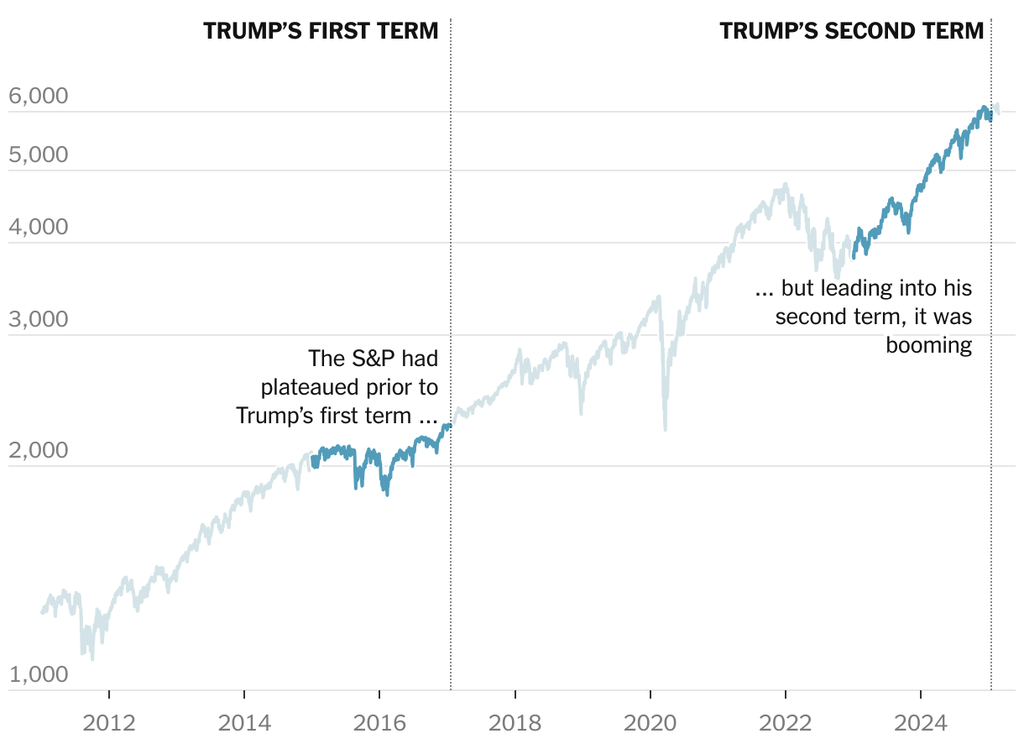
President Trump’s second term has been a major shift from his first term and a deviation from conventional bipartisan economic thought.
The most glaring example is his aggressive implementation of tariffs to reduce trade deficits and bring back manufacturing to the US.
For many decades, President Trump has been a believer in protectionism and touted tariffs as a tool to rebalance trade deficits.
In his first term, the slight headwind created by his tariffs was more than offset by supportive fiscal and monetary policy, along with strong economic fundamentals. And, it translated into impressive performance for stock prices and corporate earnings.
This time, the situation is much different beyond just tariffs. The business cycle was already turning lower before the start of his administration, based on leading indicators like industrial production, inventories, and new orders.
Monetary policy is also constrained by higher levels of inflation, while the scope of fiscal policy is limited by a deficit of nearly $2 trillion and debt servicing costs of over $800 billion.
Another difference is that President Trump was more sensitive to market signals in his first term, quickly pivoting when his proposals were met with falling stock prices.
This time, President Trump is emboldened and willing to endure short-term pain to achieve longer-term objectives.
In his inaugural speech, he pointed to failed assassination attempts and victories in the electoral college and popular vote as mandates to pursue the policies on which he campaigned. Additionally, he is willing to ignore negative signals from the market and warnings from business leaders about the difficulties created by the tariffs.
These differences indicate that outcomes for the stock market, economy, and corporate earnings are also likely to be different in his second term, compared to his first term.
Politics Increasingly Impact Markets
As an investor, it’s probably clear that we’re in an era in which politics have major ramifications for financial markets. This is a major shift from previous decades, where there was a broad bipartisan consensus on major economic issues.
Investors now have to consider these factors when making decisions.
A secondary consequence is that certain stocks can gain or weaken depending on the fortunes of politicians and political parties.
For example, defense stocks, like Lockheed Martin (NYSE: LMT) and General Dynamics (NYSE: GD) started to weaken in the middle of last year, as the odds of President Trump winning the upcoming election increased. This is due to his belief that the US should play a decreased role in foreign affairs and his unwillingness to provide support for Ukraine in its war against Russia.

The same dynamic was evident during President Biden’s tenure. As his approval ratings collapsed, green energy stocks tumbled. From 2021 to 2025, the iShares Global Clean Energy ETF fell by 65% despite the passage of the Green New Deal and a supportive administration.
On the other hand, some sectors benefited from President Biden losing popularity. This includes private prison stocks like Geo Group (NYSE: GEO) and CoreCivic (NYSE: CXW), which saw gains of 241% and 222%, respectively, during the last administration.
A Smarter Way to Research Stocks…
Zen Ratings uses 115 factors to grade each stock — and has a proven model that boasts a track record of average annual returns of 32.52% for A-rated stocks. Try it FREE today and see how the stocks in your portfolio stack up.
Donald Trump Stocks to Buy and Sell
Curious about what stocks might go up or down based on Donald Trump’s popularity? Let’s take a look.
For Investors Bullish on Trump
If an investor is bullish on President Trump and believes that his policies will work and translate into increased popularity then private prison stocks like Geo Group (NYSE: GEO) and CoreCivic (NYSE: CXW) are likely to continue outperforming.

Many other stocks and sectors could benefit as well. These include companies that are ideologically aligned with the Trump administration, like Tesla (NASDAQ: TSLA) or Palantir (NASDAQ: PLTR).
While the bulk of the focus has been on tariffs, President Trump and Treasury Secretary Scott Bessent are also embarking on an aggressive agenda to deregulate the financial sector, which could be bullish for bank stocks and lead to higher levels of profitability.
Of course, these stocks do have higher levels of risk as reflected by Tesla’s steep decline over the last couple of months due to blowback and boycotts over Elon Musk’s association with President Trump.
So, investors can mitigate this risk by utilizing a proven, quantitative system like the Zen Ratings to identify the best stocks within this group.
Stocks to Watch if Trump’s Popularity Declines
There are also opportunities for those who believe President Trump’s popularity is set to decline, setting up the Democrats to take control of the House in 2026 and the executive branch in 2028.
Democrats would likely look to undo cuts to government spending and programs, take a more proactive role in foreign policy, and re-invest in efforts to combat climate change.
These investors may want to consider investing in sectors like government contractors, defense stocks, and green energy. Some of the top-rated stocks in these categories currently include Leidos Holdings (NYSE: LDOS) and General Dynamics (NYSE: GD).
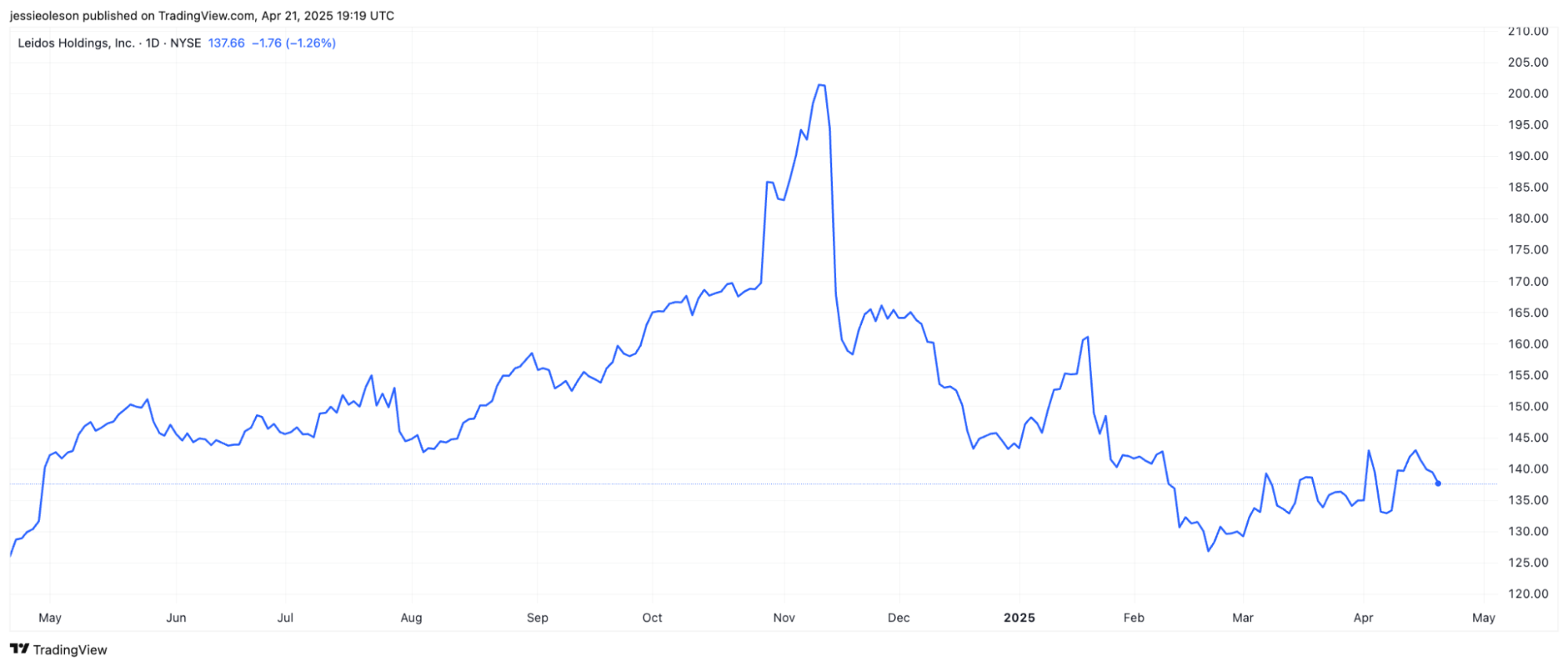
These stocks are poised to rise if President Trump’s approval ratings fall. Yet, their strong scores in the Zen Ratings also mean that downside risk is limited.
Donald Trump Stocks: What Stocks Does He Own?
Donald Trump is an unconventional politician in nearly every way. So, it’s not surprising that this extends to his wealth and personal holdings.
Traditionally, candidates for higher offices have diversified portfolios of mutual funds and ETFs to reduce conflicts of interest. In contrast, President Trump’s wealth is primarily concentrated in private assets such as his properties, real estate, and other business ventures.
Trump Media & Technology Group (NASDAQ: DJT)
His largest public holding is Trump Media & Technology Group (DJT) of which he has a 54% stake, valued at around $2.5 billion.
DJT’s major assets are TruthSocial, a social media platform, and Truth.fi, a fintech brand which offers exposure to America-first investment vehicles like ETFs. managed accounts, and crypto securities.
The commonality of all these assets is that they are connected to the value of the Trump brand. Throughout his career, he has made large bets on himself, and his personal holdings are an extension of this philosophy.
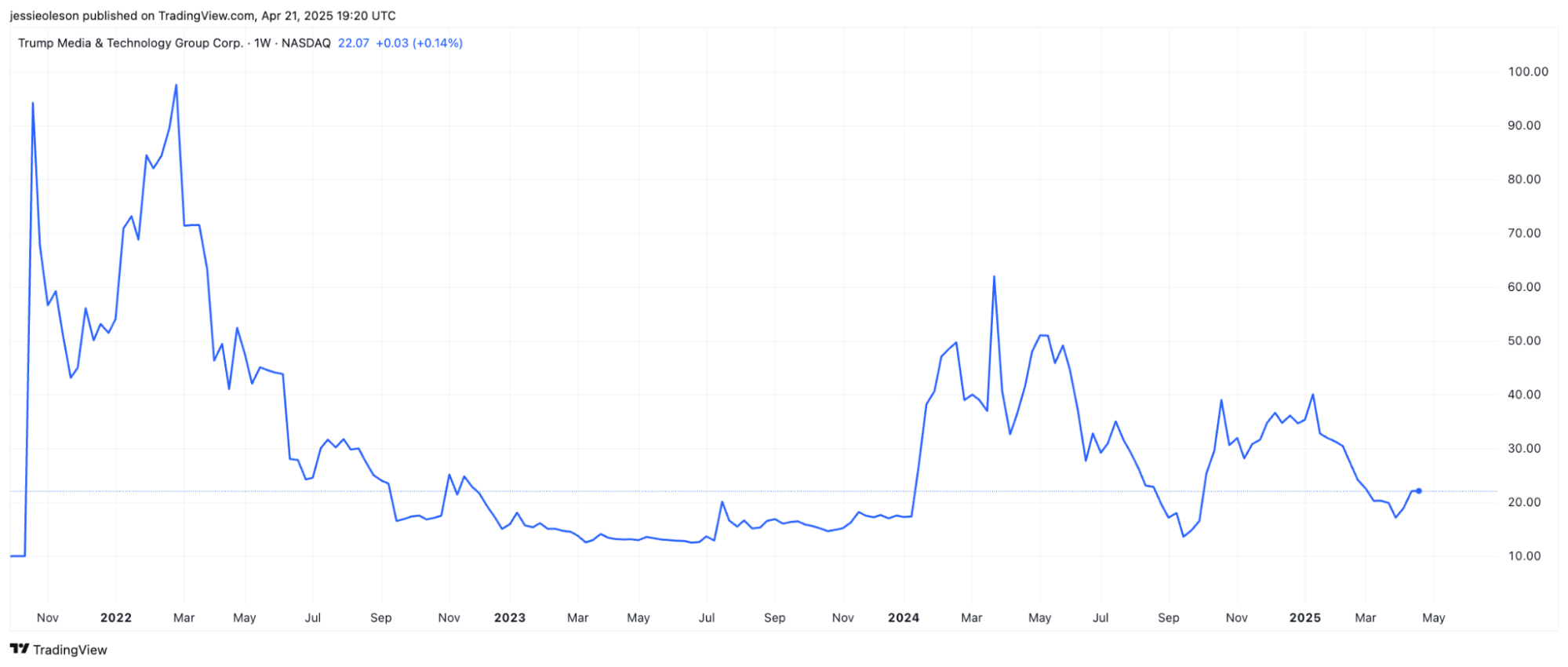
Other Reported Donald Trump Holdings
Yet, it’s still important to note that President Trump does own some individual stocks. According to financial disclosure forms, which were filed before the election, the bulk of his equity portfolio is concentrated in tech stocks.
Among these, his largest holdings are:
Apple (NASDAQ: AAPL), Microsoft (NASDAQ: MSFT), and Nvidia (NASDAQ: NVDA) of which he owns between $500,000 and $1 million.
Next are positions in Amazon (NASDAQ: AMZN) and Google (NASDAQ: GOOGL) with the value of these holdings estimated to be between $250,000 and $500,000.
Finally, he has a much smaller position in Tesla (NASDAQ: TSLA), which is estimated to be between $50,000 and $100,000.
These stakes are notable because his decisions on tariffs and any exemptions he grants have major implications for these companies.
Final Word:
Following the Watergate scandal, many began referring to the media as the 4th branch of the government, as it proved to be the ultimate check on executive overreach.
Today, many are pointing to financial markets as the 5th branch of government, playing a pivotal role in curbing the executive, especially since the other branches are being compliant, ignored, or sidelined.
This is evident in President Trump, softening his rhetoric on trade and delaying his imposition of aggressive, worldwide tariffs, following steep declines in the stock market and US Treasuries.
Markets provide a real-time, objective measure of a government’s performance. Capital flees when it’s being treated poorly or erratically.
Given President Trump’s aggressive and unorthodox style, markets will play an outsized role in terms of providing checks and balances when it comes to economic policy.
FAQs:
Is Donald Trump plotting a stock market crash?
There is no public evidence that President Donald Trump is intentionally plotting a stock market crash. However, his recent policies and statements have raised concerns among investors and analysts.
Given President Trump’s aggressive and unorthodox style, markets will play an outsized role in terms of providing checks and balances when it comes to economic policy.
Is the economy strong under Donald Trump?
As of 2025, the economy is experiencing both ups and downs. The U.S. economy is strong right now thanks to resilient consumer spending and solid corporate earnings.
However, the economy is at risk due to rising trade tensions and stubborn inflation. New tariffs on imports are straining businesses and threatening growth, while inflation remains high
Where to Invest $1,000 Right Now?
Did you know that stocks rated as "Buy" by the Top Analysts in WallStreetZen's database beat the S&P500 by 98.4% last year?
Our April report reveals the 3 "Strong Buy" stocks that market-beating analysts predict will outperform over the next year.

![How to Invest in AI Ultimate Guide [37 Artificial Intelligence Investments Stocks, ETFs, & Private Investments]](https://www.wallstreetzen.com/blog/wp-content/uploads/2024/07/How-to-Invest-in-AI-Ultimate-Guide-37-Artificial-Intelligence-Investments-Stocks-ETFs-Private-Investments.png)

